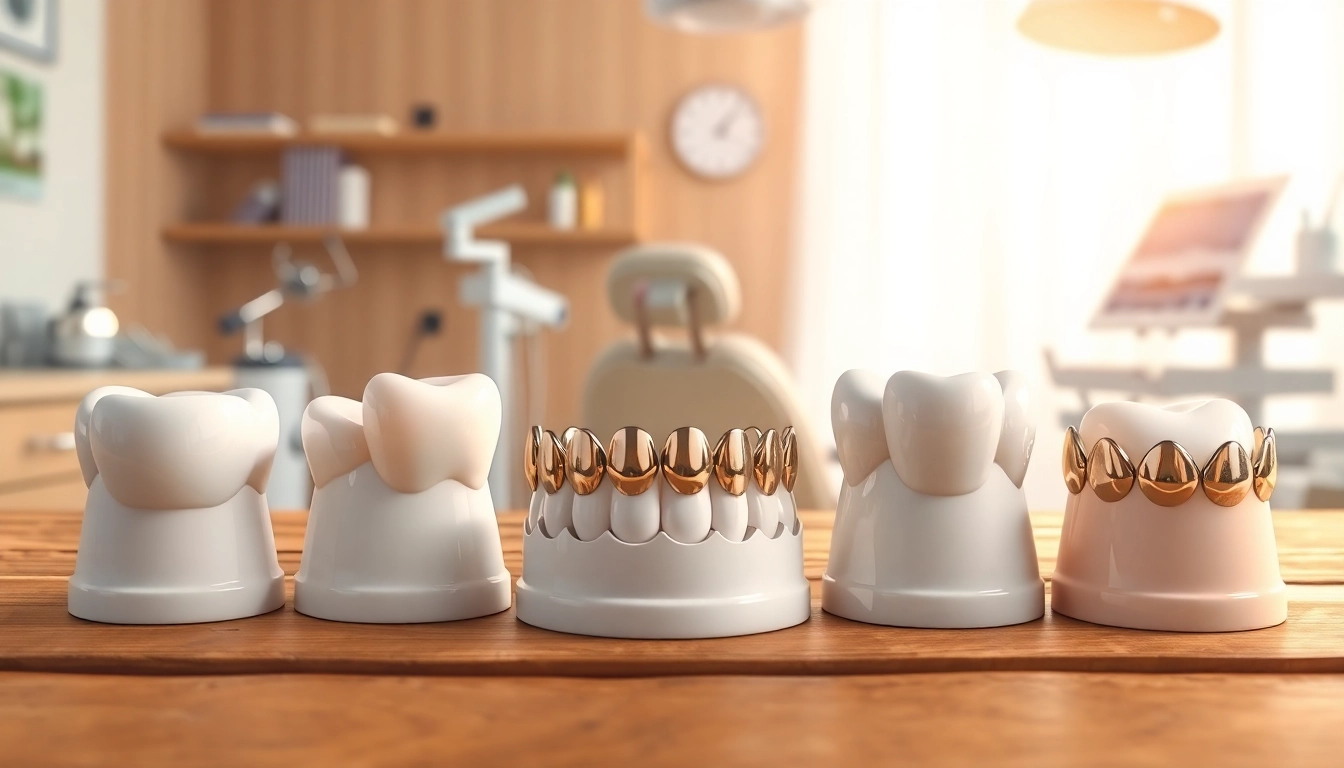What Are Dental Crowns?
Definition and Purpose of Crowns
A dental crown is a tooth-shaped cap that encases a damaged tooth, restoring its shape, size, strength, and appearance. Crowns serve multiple purposes; they can protect weak teeth from decay, hold together parts of a cracked tooth, or support a tooth that has undergone a root canal. They are also vital in covering dental implants or to enhance the aesthetic appearance of a tooth that is misshapen or discolored. Given these diverse functions, crowns are integral components in modern dentistry.
Common Reasons for Dental Crowns
Dental crowns are typically recommended for various clinical scenarios, including:
- Decayed Teeth: When a tooth has extensive decay that cannot be restored with a filling, a crown can provide the necessary support.
- Fractured Teeth: Crowns can stabilize teeth that are broken or cracked, preventing further damage.
- Post-Root Canal Treatment: Teeth that have undergone root canals often require crowns to protect them from fractures.
- Cosmetic Improvements: Crowns can enhance the appearance of teeth that are discolored, misshapen, or improperly sized.
- Supporting Bridges: Crowns can serve as anchors for dental bridges, helping to restore normal function after tooth loss.
Materials Used in Dental Crowns
Crowns can be crafted from various materials, each offering unique benefits:
- Porcelain: This material mimics the translucence of natural teeth and is favored for its aesthetic qualities. It is ideal for front teeth where appearance is paramount.
- Ceramic: Similar to porcelain, ceramic crowns are commonly used for their natural look but may be slightly less durable.
- Metal: Materials like gold or nickel are exceedingly durable, making them suitable for back teeth where biting pressure is greatest, though they are less natural in appearance.
- Porcelain-Fused-to-Metal (PFM): Combining the strength of metal with the aesthetics of porcelain, PFM crowns can be a versatile choice for many patients.
Types of Dental Crowns
Porcelain and Ceramic Crowns
Porcelain and ceramic crowns are well-known for their superior aesthetic qualities. They closely resemble natural teeth in color and translucence, which makes them an excellent option for frontal restorations. These crowns are especially beneficial for patients looking to improve their smiles without sacrificing aesthetics. However, they may not be as strong as metal crowns, making them more susceptible to chipping or cracking under excessive bite force.
Metal Crowns and Their Applications
Metal crowns, such as those made from gold, cobalt-chromium, or nickel, are chosen primarily for their strength and longevity. These crowns can withstand considerable chewing force, making them suitable for molars, where decay or damage is most common. While their metallic color may be a drawback for visible teeth, their unparalleled durability and resistance to wear make them a reliable choice.
Porcelain-Fused-to-Metal Crowns
Porcelain-fused-to-metal crowns combine the strengths of both materials, offering the durability of metal with the natural appearance of porcelain. This makes them a popular choice for various dental restorations. PFM crowns can be adjusted to match the shade of surrounding teeth, making them suitable for both functional and aesthetic purposes.
The Dental Crown Procedure
Initial Consultation and Assessment
The journey to receiving a dental crown typically begins with an initial consultation. During this appointment, your dentist will assess the health of the tooth in question, looking for signs of decay, damage, or infection. X-rays may be taken to determine the underlying condition and ensure there’s sufficient tooth structure to support a crown. Based on this assessment, the dentist will discuss appropriate treatment options and the type of crown that would best suit your needs.
The Crown Placement Process
The procedure to place a crown generally involves multiple steps:
- Tooth Preparation: The affected tooth will be numbed with local anesthesia. The dentist then removes any decayed portions and shapes the tooth to ensure a secure fit for the crown.
- Impression: An impression of the prepared tooth is taken to create a custom crown. This impression can be made using traditional methods or digital scanning.
- Temporary Crown: While waiting for the permanent crown, a temporary crown will be placed to protect the tooth.
- Crown Placement: Once the permanent crown is ready, the temporary crown is removed, and the new crown is fitted. Adjustments may be made to achieve the desired comfort and aesthetics before permanently cementing it in place.
Aftercare and Recovery Tips
After the placement of a dental crown, proper care is crucial for longevity and success:
- Maintain Oral Hygiene: Continue to brush and floss regularly to prevent decay around the crown.
- Avoid Hard Foods: In the initial days following crown placement, avoid chewing hard foods to prevent dislodging the crown.
- Follow-up Appointments: Attend follow-up appointments as recommended to ensure the crown is functioning well and there are no issues.
Benefits of Getting Dental Crowns
Restoration of Tooth Function and Aesthetics
Dental crowns serve to restore the functionality of damaged teeth, allowing patients to chew and speak effectively. Beyond function, crowns significantly enhance the aesthetics of a person’s smile. Whether it’s a discolored tooth or one that is misshaped, crowns can dramatically improve appearance, leading to increased confidence and satisfaction with one’s smile.
Durability and Long-term Care
One of the key benefits of dental crowns is their durability. Depending on the material, crowns can last for many years with proper care. Metal crowns, for instance, are known to last over 15 years, while porcelain crowns may last between 5 to 15 years. Routine dental visits and good oral hygiene habits extend their lifespan and maintain tooth health.
Enhancing Confidence Through Improved Appearance
The psychological benefits of improving one’s smile cannot be overstated. Many patients report increased confidence and self-esteem following dental crown placement. With a restored smile, individuals may feel more inclined to engage in social situations, knowing they look their best. This enhancement in self-image can lead to a positive feedback loop influencing personal and professional relationships.
Cost Considerations and Insurance Coverage
Average Cost of Different Crown Types
The cost of dental crowns can vary significantly based on several factors, including material choice, location, and the complexity of the procedure. On average, patients can expect to pay:
- Porcelain Crowns: Between $800 and $3,000 per tooth.
- Porcelain-Fused-to-Metal Crowns: Typically between $500 and $1,500.
- Metal Crowns: Generally range around $600 to $2,500.
Financing Options for Dental Procedures
Dental procedures, including crowns, can be a significant investment. Many dental practices offer financing options, enabling patients to spread the cost over time. Additionally, health savings accounts (HSAs) and flexible spending accounts (FSAs) can be used for these expenses, providing further financial flexibility.
Insurance Coverage and What to Know
Dental insurance coverage for crowns varies by provider and plan. It is important to review your specific policy, as some plans cover a percentage of the costs associated with crowns while others may have limitations based on the necessity of the procedure. Knowing your coverage can help alleviate some financial concerns related to dental work.



